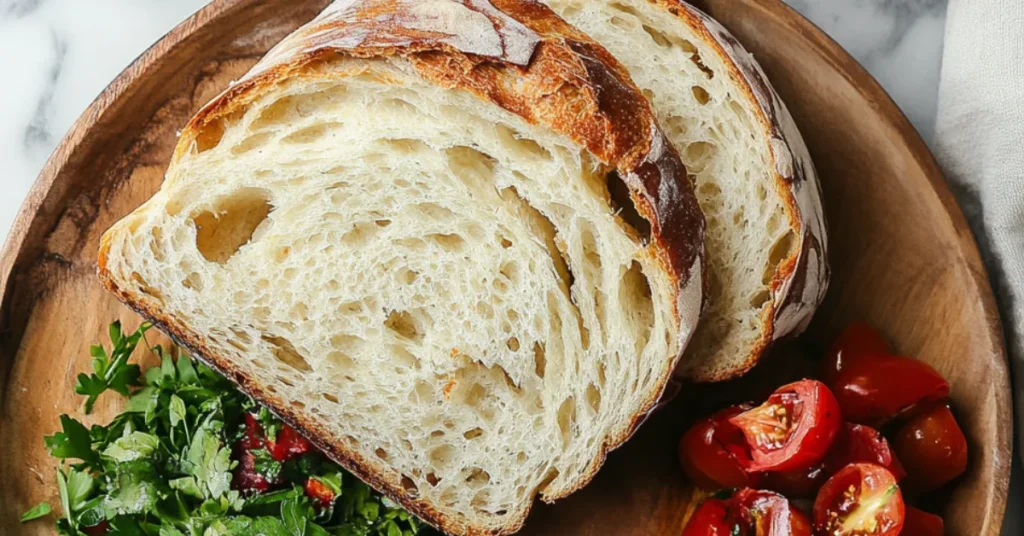Table of Contents
The Ultimate Guide to Sourdough Discard Sandwich Bread
Dive into the world of sourdough discard sandwich bread with our ultimate guide, featuring expert tips, recipes, and FAQs to elevate your baking game.
In the realm of artisan baking, sourdough bread holds a place of reverence not only for its complex flavor profile but also for its traditional fermentation process. Among the unique aspects of sourdough baking is the concept of “discard” – a byproduct of maintaining a healthy sourdough starter. This guide explores the innovative use of sourdough discard in crafting the perfect sandwich bread, offering a delicious solution to waste and an introduction to a world of enhanced flavors and textures.
What is Sourdough Discard?
Sourdough discard is the portion of a sourdough starter that is removed before feeding the remaining starter with fresh flour and water. This process is essential for maintaining the starter’s health and vigor. While it might seem wasteful, this “discard” is a goldmine for bakers looking to add depth and tanginess to various baked goods, including the beloved sandwich bread.
The Benefits of Using Sourdough Discard
Incorporating sourdough discard into your baking routine not only reduces waste but also enriches your baked goods with a subtle tang and complexity that can only come from natural fermentation. The lactic acid bacteria present in the discard contribute to a more nuanced flavor profile, while the fermentation process can improve the nutritional content of your bread, making it a healthier option.
Sourdough Discard Sandwich Bread: A Delicious Solution
Transforming sourdough discard into sandwich bread is a creative and delicious way to utilize this byproduct. This section will guide you through selecting the right ingredients, mixing, proofing, and baking to achieve a loaf that’s not only flavorful but also boasts the perfect texture for your sandwich needs.
Ingredients for the Perfect Loaf
The foundation of any good bread is its ingredients. For sourdough discard sandwich bread, you’ll need your discard, flour, water, salt, and a sweetener to balance the tanginess. Optional ingredients can include fats like butter or oil for a softer crumb, and milk for richness.
Step-by-Step Baking Process sourdough discard sandwich bread
Embarking on the journey to create your own sourdough discard sandwich bread is both an art and a science. This step-by-step guide is designed to walk you through the process, ensuring that even beginners can achieve a delicious, tangy loaf that’s perfect for any sandwich or toast. Let’s dive into the detailed process.
1. Gathering Your Ingredients for sourdough discard sandwich bread
Before you begin, ensure you have all the necessary ingredients on hand. For a basic sourdough discard sandwich bread, you will need:
- 1 cup (240g) of sourdough discard
- 2 cups (480g) of all-purpose flour, plus more for dusting
- 1 teaspoon (5g) of salt
- 1 tablespoon (15g) of sugar or honey (optional, for a touch of sweetness)
- 1/2 cup (120ml) of lukewarm water
- 2 tablespoons (30ml) of vegetable oil or melted butter (for a softer crumb)
- 1 teaspoon (5g) of instant yeast (optional, for a quicker rise)
2. Mixing the Dough
In a large mixing bowl, combine the sourdough discard, flour, salt, and sugar (if using). Mix these dry ingredients together to distribute the salt and sugar evenly. Then, add the lukewarm water and oil or melted butter. If you’re using instant yeast for a quicker rise, dissolve it in the water before adding it to the mix.
Using a wooden spoon or your hands, mix everything together until a shaggy dough forms. The dough should be sticky to the touch but should come together in a cohesive mass.
3. Kneading the Dough
Transfer the dough to a floured surface and knead for about 10 minutes, or until the dough becomes smooth and elastic. If the dough sticks to your hands or the surface, add a little more flour, but be careful not to add too much, as this can make the bread dense.
4. First Rise (Bulk Fermentation)
Place the kneaded dough in a lightly oiled bowl, covering it with a damp cloth or plastic wrap. Let it rise in a warm, draft-free area until it doubles in size, which can take anywhere from 1 to 2 hours, depending on the temperature of your kitchen and whether you used additional yeast.
5. Shaping the Loaf
Once the dough has doubled, gently punch it down to release any air bubbles. Transfer it to a lightly floured surface and shape it into a loaf. To do this, flatten the dough into a rectangle, then fold the long sides into the center, pressing down to seal. Roll the dough gently to form a loaf shape.
6. Second Rise
Place the shaped loaf into a greased 9×5 inch (23×13 cm) loaf pan. Cover it again with a damp cloth or plastic wrap and let it rise until it’s just cresting the rim of the pan, about 1 hour.
7. Baking
Preheat your oven to 375°F (190°C). Once the loaf has risen and the oven is hot, place the pan in the oven. Bake for about 35-40 minutes, or until the top is golden brown and the loaf sounds hollow when tapped on the bottom.
8. Cooling
Remove the bread from the oven and let it cool in the pan for about 10 minutes. Then, transfer it to a wire rack to cool completely before slicing. This step is crucial, as cutting into the bread too soon can result in a gummy texture.
9. Enjoying Your Bread
Your sourdough discard sandwich bread is now ready to be enjoyed. Slice it up for sandwiches, toast it for breakfast, or simply enjoy it plain with a dab of butter.
Remember, baking is a practice that rewards patience and persistence. Each loaf you bake will teach you something new about the process, allowing you to refine your skills over time. Happy baking!
Tips for Achieving the Perfect Crust and Crumb sourdough discard sandwich bread
Achieving the perfect crust and crumb in your sourdough discard sandwich bread is a pinnacle of baking success, creating a delightful sensory experience with each bite. Here are expert tips to help you master the art of baking bread with a crispy crust and a tender, airy crumb.
1. Hydration is Key
The water-to-flour ratio (hydration) in your dough significantly influences the bread’s crumb. Higher hydration doughs tend to have a more open, airy crumb and a thinner, crisper crust. For sandwich bread, a hydration level around 65-70% works well, balancing ease of handling with a soft, yet structured crumb. Adjust the water content based on the flour’s absorption rate and the desired texture.
2. Autolyse for Better Texture
Incorporate an autolyse phase into your process. This involves mixing only the flour and water and letting the mixture rest for about 20-30 minutes before adding the sourdough discard, salt, and any other ingredients. This rest period allows the flour to fully hydrate and begins gluten development without effort, leading to a dough that’s easier to shape and a bread with a better crumb structure.
3. Gentle Handling
When shaping your dough, handle it gently to preserve the gas bubbles formed during fermentation. These bubbles contribute to the bread’s rise and crumb structure. Instead of forcefully punching the dough down after the first rise, gently deflate it by pressing it out into a rectangle before shaping. This method maintains some of the air pockets, promoting a lighter crumb.
4. Steam for Crispy Crust
Steam introduced into the oven during the initial minutes of baking plays a pivotal role in achieving a crispy crust. By delaying crust formation, it permits the bread to expand maximally, resulting in a thin, crispy outer layer. This technique is essential for bakers aiming to perfect their sourdough discard sandwich bread. You can create steam by placing a pan of hot water at the bottom of the oven when you put your bread in to bake or by spritzing the oven walls with water. Be cautious and avoid oven glass doors when introducing steam.
5. Correct Baking Temperature and Time
Bake your bread at the right temperature. A too-low temperature can lead to a dense crumb and soft crust, while too high can burn the crust before the inside is fully baked. For sourdough discard sandwich bread, a temperature of 375°F (190°C) is generally effective. Adjust the time and temperature based on your oven and the bread’s color and internal temperature, which should reach about 190-210°F (88-99°C) when done.
More recipes: Easy Baked Ranch Chicken Recipe
6. Use a Dutch Oven for Even Baking
If you struggle with achieving a consistent crust, consider baking your bread in a preheated Dutch oven. The enclosed space mimics a professional steam oven, trapping the bread’s moisture to create steam while baking. This method can produce a beautifully crispy crust and evenly baked loaf.
7. Cooling Matters
Allow your bread to cool completely on a wire rack before slicing. Cutting into the bread too soon can release steam inside, resulting in a gummy crumb. Cooling gives the crumb structure time to set and the crust to develop its final texture.
8. Experiment with Scoring
Scoring (making shallow cuts on the dough’s surface before baking) isn’t just for aesthetics; it helps control the direction in which the bread expands. For sandwich bread, a single, lengthwise slash down the center or a few diagonal slashes can ensure even rising and contribute to the crust’s texture.
By following these tips, you’ll be well on your way to baking sourdough discard sandwich bread with a perfect crust and crumb. Remember, baking is as much about intuition and experience as it is about precision, so don’t be afraid to experiment and adjust based on your observations and preferences. Happy baking!
Creative Variations of Sourdough Discard Sandwich Bread
Exploring creative variations of sourdough discard sandwich bread can transform your baking routine, introducing new flavors and textures to your repertoire. These variations not only make use of your sourdough discard but also cater to diverse tastes and dietary needs, ensuring everyone can enjoy the delightful experience of homemade bread. Here are some innovative ideas to inspire your next baking adventure.
1. Whole Grain and Seed Bread (sourdough discard sandwich bread)
Incorporate whole grains such as whole wheat flour, rye, or spelt into your dough to enhance the nutritional profile and add a rustic flavor. Mix in a variety of seeds—such as sunflower, pumpkin, sesame, and flaxseed—for a crunchy texture and a boost of healthy fats. Adjust the hydration level as whole grains and seeds tend to absorb more water.
2. Herb and Garlic Bread (sourdough discard sandwich bread)
Elevate your sourdough discard sandwich bread with the aromatic flavors of fresh or dried herbs. Mix herbs like rosemary, thyme, and oregano into the dough. For a more pronounced flavor, add minced garlic or garlic powder. This variation is perfect for savory sandwiches or as an accompaniment to soups and salads.
3. Cheese Bread (sourdough discard sandwich bread)
Incorporate grated cheese such as cheddar, Parmesan, or Gruyère into the dough for a deliciously cheesy loaf. You can also add cubes of cheese for pockets of melted goodness. Consider combining cheese with jalapeños or sun-dried tomatoes for an extra flavor kick. Cheese not only adds flavor but also contributes to a softer crumb.
4. Cinnamon Raisin Bread (sourdough discard sandwich bread)
For a sweet twist, add cinnamon and raisins to your sourdough discard dough. The warmth of cinnamon paired with the sweetness of raisins makes for a delightful breakfast bread, perfect for toasting. Ensure the raisins are evenly distributed throughout the dough for a consistent flavor in every slice.
5. Olive and Roasted Red Pepper Bread (sourdough discard sandwich bread)
Mix chopped olives and diced roasted red peppers into your dough for a Mediterranean-inspired loaf. The briny olives and sweet peppers add bursts of flavor and color to the bread. This variation pairs wonderfully with cheese platters or as a base for open-faced sandwiches.
6. Gluten-Free Sourdough Discard Bread (sourdough discard sandwich bread)
For those avoiding gluten, create a gluten-free version of sourdough discard sandwich bread using a blend of gluten-free flours such as rice flour, buckwheat flour, and almond flour. Add xanthan gum to help bind the dough and mimic the texture of gluten-containing bread. Note that gluten-free versions may require different hydration levels and baking times.
7. Vegan Sourdough Discard Bread (sourdough discard sandwich bread)
Make your sourdough discard bread vegan by substituting any dairy or animal-derived ingredients with plant-based alternatives. Use olive oil or coconut oil instead of butter and choose a plant-based milk or simply water for hydration. Experiment with adding vegan cheese or plant-based proteins for a hearty loaf.
Experimenting with Your Own Variations (sourdough discard sandwich bread)
The beauty of baking with sourdough discard sandwich bread is the endless possibilities for creativity. Don’t be afraid to experiment with different combinations of flavors and ingredients. Consider what you have on hand in your pantry or what seasonal ingredients could inspire your next loaf. Adjusting hydration, fermentation times, and baking temperatures can help accommodate the unique characteristics of your added ingredients, ensuring a successful and delicious variation every time.
FAQs About Sourdough Discard Sandwich Bread
Why use sourdough discard in sandwich bread?
Using sourdough discard adds depth and tanginess to the bread and is a great way to reduce waste from maintaining a sourdough starter.
Can I make this bread without additional yeast?
Yes, but expect a longer rise time as the natural yeasts in the discard work more slowly than commercial yeast.
How do I store this bread?
Store cooled bread in a bread box or wrapped in a cloth inside a bag at room temperature for 3-4 days, or slice and freeze for longer storage.
Can I use whole wheat flour?
Yes, whole wheat flour can replace all-purpose flour, but you may need to adjust the hydration due to its higher water absorption.
My bread didn’t rise much. Why?
Possible reasons include inactive sourdough discard, too low fermentation temperature, or overproofing. Ensure your discard is active and ferment in a warm spot.
How can I get a softer crust?
Brush the crust with melted butter or oil after baking, or bake at a lower temperature for a softer crust.
Can I add ingredients like nuts or dried fruit?
Yes, add nuts, seeds, dried fruits, cheeses, or herbs during the final kneading to evenly distribute them.
Is scoring necessary?
Scoring isn’t necessary for loaf pan bread but can help control expansion and prevent undesired cracking.
Conclustion
In conclusion, baking sourdough discard sandwich bread is a rewarding way to utilize sourdough discard, adding unique flavors and reducing waste. Whether incorporating whole grains, experimenting with add-ins, or adjusting recipes for dietary needs, the versatility of sourdough discard bread caters to all tastes. Remember, successful sourdough baking combines patience, practice, and a willingness to learn from each bake. Happy baking!




